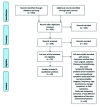The relationship between overactive bladder and prostate cancer: A scoping review
- PMID: 33591905
- PMCID: PMC8490099
- DOI: 10.5489/cuaj.7058
The relationship between overactive bladder and prostate cancer: A scoping review
Abstract
Introduction: The relationship between prostate cancer (PCa) and overactive bladder (OAB) is poorly understood. PCa and OAB are frequently diagnosed in elderly populations, so it could be expected that both conditions would be observed in older patients. Whether PCa and OAB occur independently with age, or the presence of PCa leads to the onset of OAB/lower urinary tract symptoms (LUTS) has not been explored. This review aimed to investigate whether men newly diagnosed with PCa are more likely to have OAB compared to the general population, and if the various treatment modalities for PCa are likely to impact the incidence or exacerbation of OAB.
Methods: The University of Calgary's databases for Medline and PubMed were searched for relevant publications. No restrictions were placed on the study design reported. Any publications reporting OAB and a PCa diagnosis and/or observation relating to PCa diagnosis and rates of OAB/LUTS in an adult population were included for full review.
Results: Of the studies examining the relationship between PCa and LUTS, results varied, but frequently indicated an inverse association between PCa and LUTS in which patients newly diagnosed with PCa were more unlikely to have LUTS compared to the general population. Following treatment, brachytherapy resulted in a higher prevalence of OAB symptoms compared to surgical treatment and external beam radiation therapy.
Conclusions: Diverse evidence was found regarding the relationship between the prevalence of pre-treatment OAB and PCa diagnosis. However, limited evidence, as well as uncertainty regarding pre-treatment symptoms and their impact on post-treatment outcomes, restricts potential conclusions.
Conflict of interest statement
Figures
References
-
- Spickett I, John R. Prostate cancer: The ongoing challenge. Prim Health Care. 2010;20:16–21. doi: 10.7748/phc2010.03.20.2.16.c7598. - DOI
Publication types
LinkOut - more resources
Full Text Sources
Other Literature Sources


